You can read the whole article or just jump to what interests you most.
Page created early March...last updated July 13th, 2003.
Toshiba has halted sale of the E740 and has not provided access to the PocketPC 2003 upgrade software. Unfortunately, the E740 is plagued not only by lack of speed ,but also by hardware bugs that Toshiba America won't fix.
This course of action from Toshiba made us change our review from one of moderate recommendation to a definite negative.
The Hardware
Software
Upgrading (at least there is the possibility)
XScale (or where they hid the 400MHz at!)
Final Word
Hardware
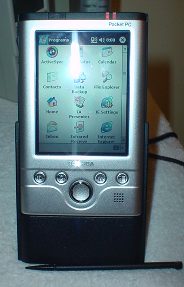 Office Depot recently had a large PDA sale. For those not familiar with it, one could trade in an old PDA and get a $100 mail-in rebate from Office Depot and Toshiba for purchase of one of their PDAs. I decided to get one mainly for use as a truly portable computer as opposed to a simple personal information manager.
Office Depot recently had a large PDA sale. For those not familiar with it, one could trade in an old PDA and get a $100 mail-in rebate from Office Depot and Toshiba for purchase of one of their PDAs. I decided to get one mainly for use as a truly portable computer as opposed to a simple personal information manager.The PocketPC offers a very good platform for general purpose software of all types with such things as powerful CPUs, well developed color displays and a variety of input/output as well as expansion ports. Lots of memory is also commonplace.
Toshiba offers a variety of different models from the very basic E330 model all the way up to the presently top of the line E740. While I had initially planned to purchase the E330 or 335 models, the lack of a removable battery and 200 or 100MHz slower processor helped make my decision to buy the upper-end E740.
Now I have been living with the unit for a while now, and I certainly agree with much of what the reviews are saying: It's a good buy and a nice unit. The processor is fast, and the inclusion of both CompactFlash and Secure Digital slots is certainly a nice touch. Toshiba also throws in a nice (if a bit focused) software bundle with the unit, including a program that lets you give mobile presentations. Firmware and the OS are flash upgradeable allowing for future versions of the PocketPC/Windows CE OS. There are some disadvantages though. In summary, the most severe of these are the limited synchronization options and also what I feel have been a few too many soft resets.
In detail, the first thing I will commend Toshiba for is the excellent software support that this PDA already has. Clearly it is a popular unit and that has certainly helped produce plenty of software for it already...but popularity isn't everything to getting lots of software developed for your product. Some of the large selection of software is provided just by selection of the Intel PXA250 processor that's used. It's a common choice in Pocket PCs.
I must admit that despite the large software selection and trouble free performance of most software--even that not written exclusively for it---the mobile version of RealOne player (which doesn't have a version for the Toshiba E740, though it does have a version for the lower models) does not function correctly with the E740. Network and playback problems are both common occurences. To be fair, I cannot say if this is a hardware problem or if Real needs to work on their software some more. Some other software packages I have tried (such as NoviiRemote) have run but not quite correctly.
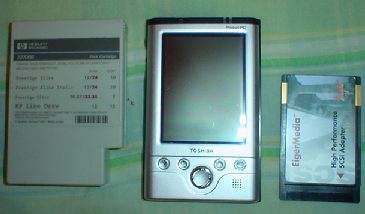 Also to be commended is the mostly excellent design of the unit. Even with dual expansion slots (one for SD and the other for CF cards) the unit is very thin and lightweight. This makes for a PDA that's not only very capable and can run lots of software for the Pocket PC that's out there now, it's also easy to take it along with you.
Also to be commended is the mostly excellent design of the unit. Even with dual expansion slots (one for SD and the other for CF cards) the unit is very thin and lightweight. This makes for a PDA that's not only very capable and can run lots of software for the Pocket PC that's out there now, it's also easy to take it along with you.Looking at the bottom edge, again you can see
 that the unit is actually very thin. Looking at the bottom also reveals the switch which controls the onboard wireless network adapter. Integrated WiFi is a nice touch and is very useful for retrieval of e-mail or lightweight web browsing. In our testing experience, the onboard WiFi adapter works very well and we have had nearly no problems using it. Others have mentioned that the WiFi quits working after certain software installations but we have been unable to duplicate this.
that the unit is actually very thin. Looking at the bottom also reveals the switch which controls the onboard wireless network adapter. Integrated WiFi is a nice touch and is very useful for retrieval of e-mail or lightweight web browsing. In our testing experience, the onboard WiFi adapter works very well and we have had nearly no problems using it. Others have mentioned that the WiFi quits working after certain software installations but we have been unable to duplicate this.With the onboard WiFi adapter you can also synchronize to your desktop or laptop computer. You can even remain connected to the ActiveSync desktop software to do such things as perform backups or even install and remove software programs.
We have only a few minor complaints with the WiFi adapter. First, when you synchronize, the connection between handheld and desktop PC is not easily broken short of powering off the unit. (Actually, we have found that opening ActiveSync on the device and tapping "stop" will disconnect you, though this does not seem to be documented anywhere.) If you should need to dock the unit after using wireless sync this could be a problem. Another of our complaints is the relatively short range of the adapter. While the adapter continues to work quite far away from our access point it seems that signal strength is shaky and falls off quickly even from short distances of only a room or two away from the access point.
The IR hardware though certainly present leaves a lot to be desired. The port is on the side where it would have been better placed at the top of the unit. (Who wants to hold their PDA sideways to beam information?) It seems that the implementation is barely functional. We had no problems sending files to the E740, but attempts with both a Compaq LTE 5000 and an IBM Thinkpad 760EL at receiving files from the E740 failed with transfer suddenly being broken off.
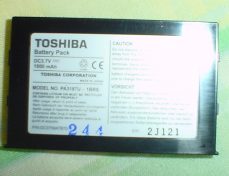 Battery life is the most important point of any mobile device like the E740. Thankfully it doesn't disappoint in this regard. The provided battery will run the unit for about 2 hours with reasonable use of the WiFi adapter and moderated backlight settings. When we used the PDA to play an audio book with the backlight off we got at least three hours out of it before we tired of listening. The battery was still pretty well charged though.
Battery life is the most important point of any mobile device like the E740. Thankfully it doesn't disappoint in this regard. The provided battery will run the unit for about 2 hours with reasonable use of the WiFi adapter and moderated backlight settings. When we used the PDA to play an audio book with the backlight off we got at least three hours out of it before we tired of listening. The battery was still pretty well charged though.Toshiba does offer for sale a much larger battery (in terms of both capacity and actual size). It clips onto the back of the PDA, thereby making it a bit thicker to hold though it should run much longer with that battery. The cost of this battery is about $120, which we feel is kind of expensive for such a battery, especially given the decent lifetime of the included battery. Of course, if you use a modem or other power hungry device with your PDA, you might really appreciate the extra runtime of the battery.
Getting the battery in and out is an easy enough task. Toshiba designed a very solid locking mechanism for the battery that holds it in securely. While we like this design very much, the battery could probably be made to move in and out of position a little more easily than it does now.
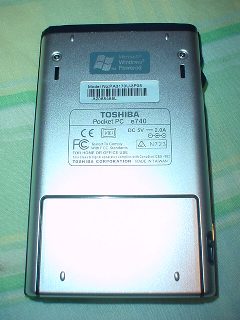
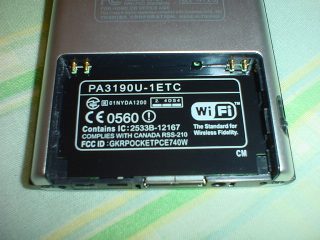
A small drawback to any Windows CE or PocketPC device we've ever seen or used is the lack of nonvolatile main memory. The Toshiba PocketPC E740 is no different in this regard. It uses volatile memory for its main storage. That is to say that if power is removed the memory loses its contents. Thankfully Toshiba does provide at least a small "buffer" of some kind to keep the memory running while batteries are removed or changed. Still, we'd like to see a PocketPC that uses some kind of nonvolatile RAM as is used on flash storage cards.
While on the subject of memory, the Toshiba E740 comes with 64MB of main memory. This memory is shared between storage and programs that are running. In our tests this has turned out to be enough memory for most programs that we used on the PDA. However, with some of the intended uses for this devices being media playback or even audio book playback, we feel the amount of main memory should at least have been doubled to 128MB. Also, some programs are rather large (like the Adobe Acrobat mobile reader program). We would highly recommend purchase of an additional CompactFlash or Secure Digital card for use with this PDA if you want to load large programs or play media clips.
If you want to use the PDA to play back MP3 or Windows Media format files, you won't be disappointed by either audio quality or volume from the earphone port. Output is stereo and it drove an average pair of earphones quite well. It also worked well with a cassette shell adapter used to feed the audio into a tape player.
The unit has a multipurpose port at the bottom for connection to at least the USB cradle and an external display adapter. There is probably more functionality than that present, but we don't see Toshiba providing cables for sale to use the plug as a serial port or even break it out into a variety of ports...which could be useful. It would be nice to see at least a pinout of the connector, so that those with the experience could make their own "breakout boxes" or optional connections.
As mentioned before, overall design of the unit is excellent. It isn't rounded like the Compaq iPaq, but rather is a much more squared off design, which we prefer. However, there are a few things about the design that aren't so great. The IR port is located on the side of the device, making it a bit of a hassle to link it up with another computer or PDA. Another small design problem is the location of the voice recorder button. Whenever we grabbed the PDA to pick it up or remove it from the provided slipcase, we found ourselves always hitting the voice record button and turning the unit on. It proved annoying enough to turn the voice recorder shortcut off, but that didn't stop the unit from turning when the button was pressed.
The carrying case provided for the unit is certainly more than adequate and is easy to use. We'd prefer it if Toshiba had included a case where the PDA could remain inside and simply have the front cover flipped open, though. At least such a case is offered as an option.
Software
Now our review comes to the software offered on the unit. A lot is offered as part of the PocketPC OS as burned into the ROM. You get Microsoft's Pocket Word, Excel, Internet Explorer, Reader, Pocket Outlook, some sync utilities and the card game Solitaire provided with the basic OS. There is also a complete control panel that lets you adjust many different settings. The Windows Media Player 8 and a File Explorer program are also included.
All of the included programs are certainly well done, but we would prefer that they used the same file formats as their desktop counterparts, especially Pocket Word and Excel. This would make transfer so much easier on a computer without the ActiveSync facilities.
For handwriting recognition, you get a few different choices. The basic keyboard is probably the least error-prone input method you can use, but the handwriting options aren't bad either. You can choose from both a "full sentence" recognizer where you write out a passage and then wait a moment or you can choose to write a character at a time. You can also choose to recognize text already written from the note pad application.
While we did choose not to use all the software provided on the bonus CD, we did install a few things the first of which was the IA Presenter program. This is a program that allows you to display a PowerPoint slide show from your Pocket PC. It does a respectable job displaying any of the slide shows we downloaded to our E740, but some transitional effects and all wave sounds were lost in the conversion. That was something of a disappointment considering the E740's enormous processing power. We were surprised that the program could not directly play a PowerPoint slide show without conversion to "pocket presentation" format...a feature that might come in handy during an emergency slide show. Finally, the IA Presenter program can connect to an external display adapter that's available as an option for your E740.
The other thing we installed was the Adobe Acrobat reader for PocketPCs. Apart from a rather large total size, this program also works well and PDF documents are amazingly readable. There is one problem though--conversion takes a very long time for most PDFs.
Mentioned earlier in this review was the E740's ability to run lots of existing packages for PocketPCs using the ARM processor. The processor used in the E740 is a variant of the ARM design, known specifically as the Intel PXA250. It runs at 400MHz. Now that sounds very, very impressive, and for most applications performance is very good with no sign of a delay or "lag" in response to user input and processing. What's disappointing is the way some software behaves. Some programs run very poorly in terms of speed or stability...but to be fair we'd expect that from such a new platform running software not written explicitly for it. The trouble is that some of the built in applications have problems with response time or stability and that is simply inexcusable for software built into the device. By far, Pocket Internet Explorer suffers the most from this problem especially on long pages.
Also on our list of minor annoyances is the lack of detail presented in some of the software. It's easy to see that Toshiba didn't make the E740 (It's made by Compal) but still they should have supervised the development process a little more closely. There are some places where the dialogs were clearly not written by people who deal with the English language every day. (For those who think we're picky, we'd expect the same from other language versions of this unit, though we haven't tested those and cannot say if they have the same grammar issues ours does or not.)
Another minor annoyance is the inability to play .WAV files on the device in any way. There's a .WAV player program, but it appears to be far less flexible than the one used in previous generations (versions 2.11 and 3.0) of the Windows CE operating system. The built in Windows Media Player doesn't even handle .WAV audio, a curious oversight indeed.
Something else we found curious: The built-in File Explorer program offers the ability to browse network resources, but you can't open anything stored on remote computers without first copying it to your device. In a way that makes sense to keep someone from running inappropriate programs not made for the device, but for documents and other files, opening them remotely should be allowed. Also, why can't one access the device from the network as a server?
Our final little set of annoyances concern the behavior of the start menu and wireless network control icon. We elected to customize our start menu and background wallpaper only to find that occasionally the unit would totally disregard our color selection and turn the text on the start menu totally white. Also bothersome was the tendency for the wireless on/off control icon to appear slowly.
Other reviewers have said that certain software installs can leave parts of the E740 not working. This strikes us as odd and we couldn't duplicate the effect even with packages said to cause problems. Maybe it's because our unit was upgraded nearly immediately with a new flash ROM and Pocket PC 2002 OS SP1.
That's pretty the software side of things. In summary, most packages run very well but many have some nagging little problems. The built in software works reasonably well but does have some annoying quirks too, and we feel that is entirely unncessary given the close relationship to the device and its built in software.
Upgradability
The topic of future expansion and upgradeability is something any PDA buyer should be concerned with. It's not enough to know that your PDA's software can be upgraded either...as some models that can be upgraded don't have fast enough CPUs or nearly enough RAM to take the upgrade software well.
If anything, Toshiba is rather light on the included RAM in the device but the basic OS and tools don't take up that much space since they reside largely in ROM. The processor and other components should allow years of upgrades and good service.
Upgrading is easy and one upgrade (as of this writing) has already been released. It is highly recommended that one obtains and installs this upgrade as it fixes several problems, upgrades your boot ROM and updates the OS to PocketPC 2002 Service Pack 1.
Should you decide to apply the update, keep in mind that it will destroy all the data on your device. Back it up first before attempting the upgrade if you value the data stored on it. Also keep in mind that after restoring the backup, you may need to recreate the "partnership" the device creates with ActiveSync.
Toshiba insures that you can upgrade as much as you'd like or need to with the inclusion of flash support. Using flash ROM means that an upgrade can simply be downloaded to the device. (Of course, any flash operation presents a risk to your device, so we don't really recommend applying the updates made available unless you really need them.)
So Just How Fast Is It Really?
We didn't do any hard and fast benchmarks. These are just observations with some applications.
One big problem--network streaming playback or playback over a network (with the help of BizzDev's NetUse tool to map a network path to a storage "card") was substantially less than satisfactory. Constant buffer underruns caused constant dropouts in the music. Also, streaming playback may be supported in many forms by the actual Windows Media Player software, but it would appear that very little content exists that can actually take advantage of this. Also, where "clicking" an audio or video link would play it directly (if possible) on a desktop computer, the E740's software requires that you download and save the file before you can play it.
Playing MP3 files from our IBM PC Server (a 486 machine with Pentium Overdrive CPU) and also from a 1.1GHz Compaq desktop proved to be less than satisfying as well. It appears that the Windows Media player uses too little of a buffer and that the E740's wireless NIC simply can't shovel the data fast enough. Playback was very broken up, stopping every 2 seconds for more 'buffering'. Though this could be a hardware limitation more than anything else, a larger or (even better) a user configurable buffer would solve the problem completely. (We tested this theory with the excellent PocketDIVX player...)
Playback of videos is not what it should be either. Though the E740 uses an ATI graphics system (seemingly unlike most other PDAs where the main CPU does all graphics rendering as well) Windows Media and MPEG videos don't play very well. This really seems to be a CPU issue more than anything else. We overclocked the unit from 400MHz to 472MHz and got all videos playing very smoothly as a result.
Now here's what I don't understand--the Intel XScale PXA250 CPU in use is a 400MHz part and IS clocked that fast. Now I know that 400MHz across CPUs and architectures is not a solid measurement with identical results from each machine. But when a Pentium 133 desktop is able to browse massive file lists, play MP3, play videos and do other things that choke the E740's CPU--there's clearly a severe software inefficiency. But just how bad can it truly be? Can Toshiba and Microsoft really have produced such poorly optimized software for the unit? And what's more important than even that--will they ever fix it? Toshiba has only released the one update since the E740's introduction and while it did help a little bit, performance is still worse than it should be.
Thankfully there is at least a bit of a workaround. Apparently Intel wasn't kidding when they called the processor an "XScale". It can be overclocked by quite an impressive margin and still perform well. Share-and-freeware programs exist to let you do this. We've run the E740 here up to both 472MHz (from the rated 400) and also to a little bit over 500MHz. It hasn't experienced any problems and performance got quite an impressive boost. Almost enough to make up for the bad software coding, but only almost. And there's the small problem of invalidating your warranty or even possibly damaging the unit. Some are not nearly as forgiving as others...with an immediate and hard lockup being the result the very instant an overclock setting is applied. Ours has run for nearly a week fully powered at 500MHz, cradled, connected to ActiveSync, running several programs and it has been extremely stable. It gets a little warmer than normal when used hard, but nothing that would suggest cause for concern.
The good news about the processor's speed is that most all the bundled apps (with the exceptions of the Windows Media Player and Pocket IE) do run faster on it than they do on other PDAs. Also good news--many other applications, even those not written specifically for the XScale design, also run somewhat faster. It's just that when you get to "hammering" the CPU that there is any sign of trouble.
Final Word
So what's the final summary? With some minor reservations already noted and even some less than minor ones regarding overall software optimization for the hardware--we'd recommend it. However, Toshiba really needs to work out many software issues, improve the "fit and finish" on the software (proper English would be nice) and vastly expand the synchronization abilities of the device before we'd recommend users of older non-USB computers go out and buy one. The number of soft-resets required and the responsiveness of the included software/hardware could also be majorly improved upon. Other than those problems, it's a fine PDA and an excellent ultra-portable "computer".
The asking price of roughly $700 is high, but you can probably buy the unit for less at certain retailers. As remarked at the beginning of this review, we obtained ours on sale and paid only about $500 which we feel is a fair price.
With this review, we've tried to be as unbiased as possible. Toshiba didn't send us a unit at a reduced cost, we went out and bought one as we had an interest in it. In other words, our experiences may differ slightly from yours, but since we bought one as anyone else would, you're likely to see a lot of the same good points and problems that we did.
Go Back>